Last edit by: IB Advertising
See related guides and technical advice from our community experts:
- Toyota Tacoma How to Combine Front and Rear Antennas<br>Step by step instructions for do-it-yourself repairs.
Guide on How to Combine Both Front & Rear Antennas into One on an Aftermarket Stereo
#1
Thread Starter
Contributing Member
iTrader: (1)
Joined: May 2006
Posts: 2,262
Likes: 1
From: B'ham, AL
Figured this info deserved it's own thread. 
The stock CD/cassette/AM/FM stereo has a diversity antenna setup that uses both the normal-sized front fender antenna jack and the smaller-sized rear window antenna jack. However, aftermarket stereos only accept the normal-sized front fender antenna jack. I installed my new Pioneer 4100 as such and noticed a decrease in reception quality. To defeat this and turn both front antenna and rear diversity antenna into one big antenna, hereís what I used:
1. METRA 40-UV43 Motorola Antenna Y-adapter = $9.06 from Amazon ($3.58 + $5.48 shipping)
2. Scosche Mda-B Micro/Delco = $4.95 from Amazon (free shipping)
The Y-adapter has 2 normal-sized female jacks going to 1 normal-sized male jack:
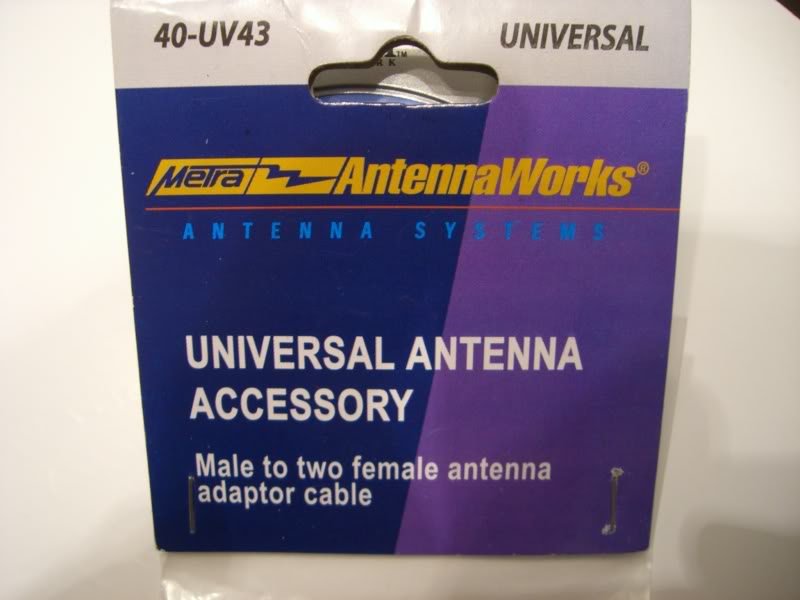
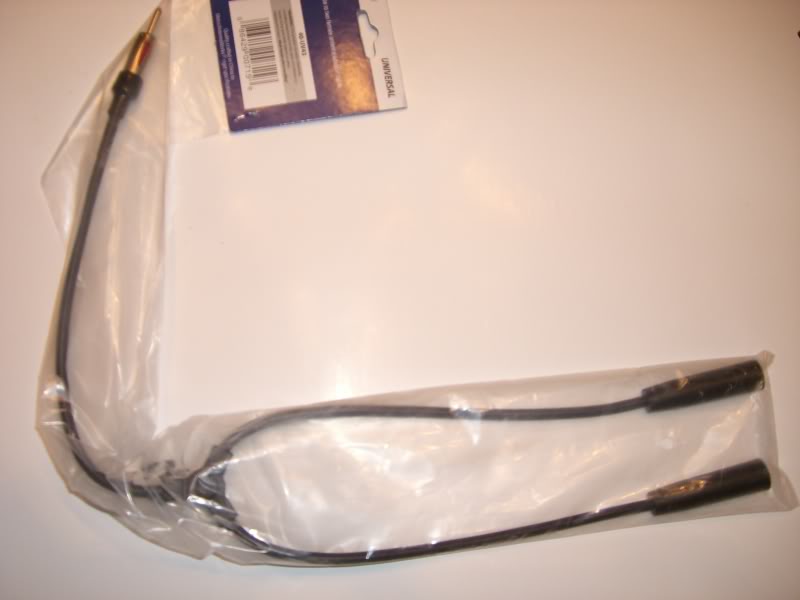
The Scosche Mda-B adapter converts the smaller rear antenna jack into a normal sized antenna jack:
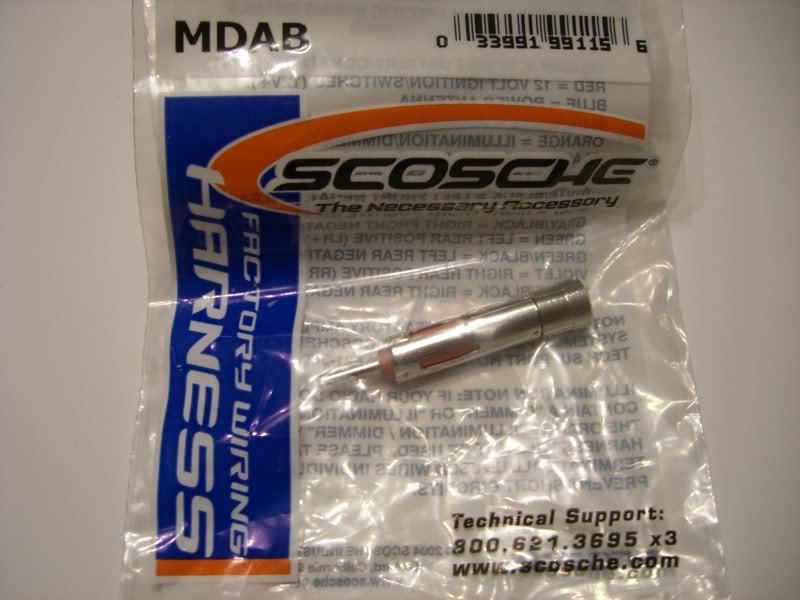
Stock 2 antenna jacks:
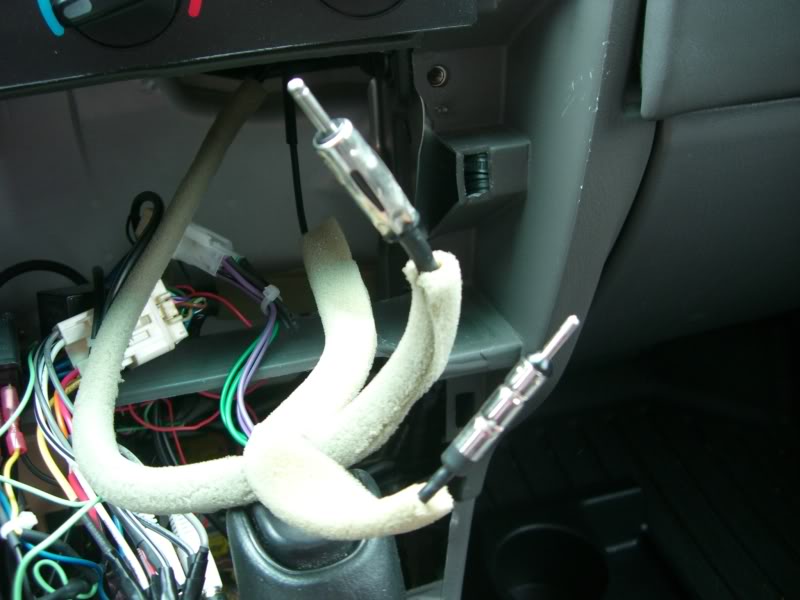
Plug the rear antenna jack into the Scosche adapter:
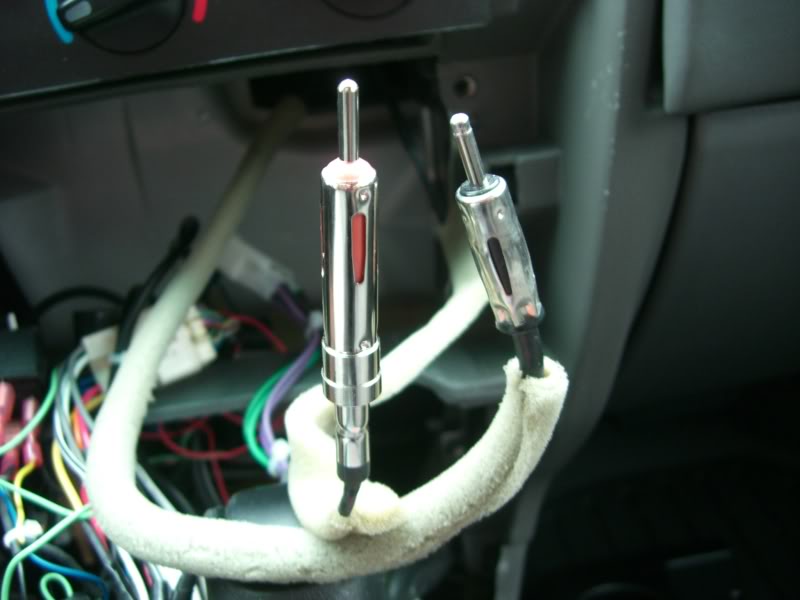
Plug the Scosche adapter into one of the Y-cableís female jacks. Plug the front fender antenna jack into the other Y-cable female jack:
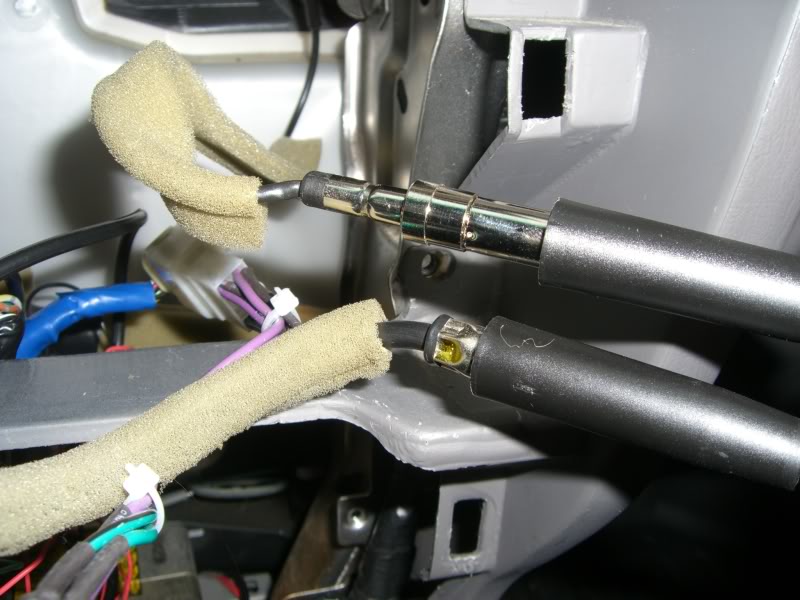
No photo, but to finish, just plug the Y-adapter's male jack into the back of your stereo.
The Metra 40-GM10 GM Antenna Adapter is another adapter that works just as good as the Scoshe adapter, but itís more expensive and roughly 10Ē long. It was on Amazon for $11.77. I bought it to try it out, but since the Scosche adapter works just as well, Iíve since returned this one:
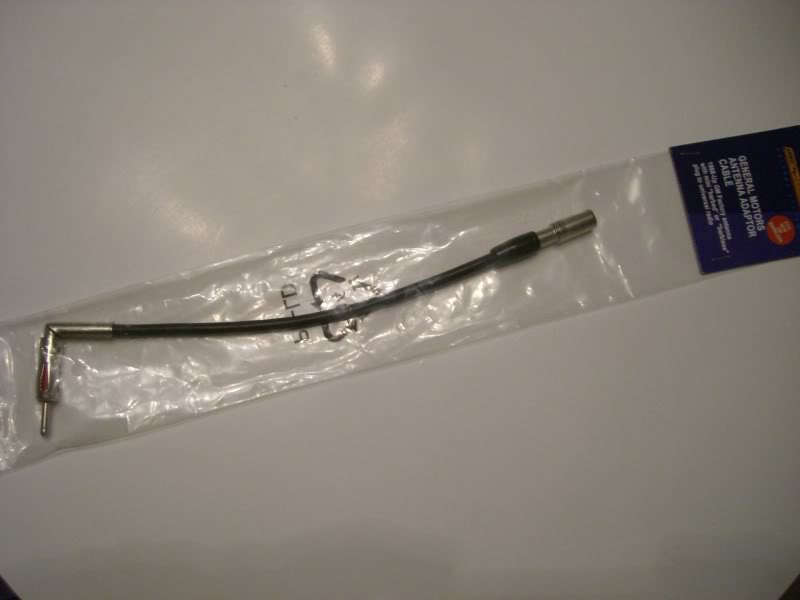
Now I can flip my antenna switch to lower the power antenna and still get good stereo reception since the rear glass antenna is now active :
:
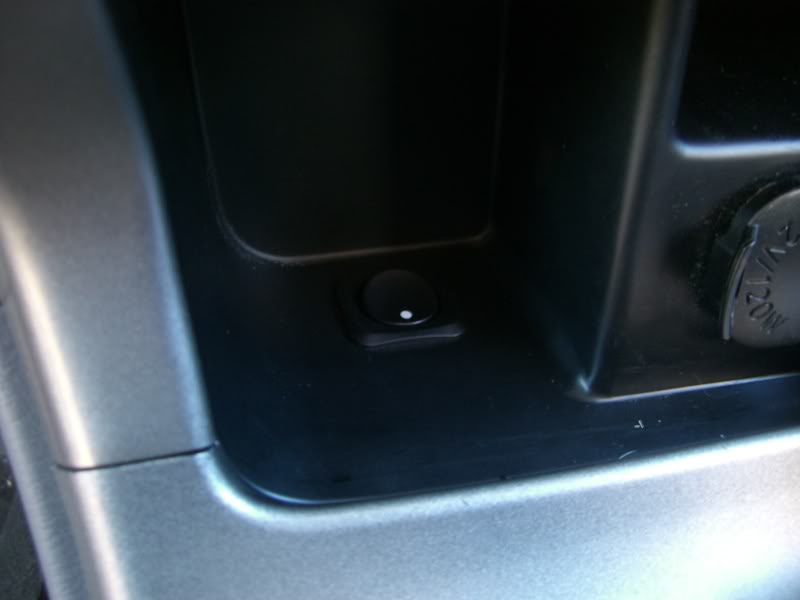
**

The stock CD/cassette/AM/FM stereo has a diversity antenna setup that uses both the normal-sized front fender antenna jack and the smaller-sized rear window antenna jack. However, aftermarket stereos only accept the normal-sized front fender antenna jack. I installed my new Pioneer 4100 as such and noticed a decrease in reception quality. To defeat this and turn both front antenna and rear diversity antenna into one big antenna, hereís what I used:
1. METRA 40-UV43 Motorola Antenna Y-adapter = $9.06 from Amazon ($3.58 + $5.48 shipping)
2. Scosche Mda-B Micro/Delco = $4.95 from Amazon (free shipping)
The Y-adapter has 2 normal-sized female jacks going to 1 normal-sized male jack:


The Scosche Mda-B adapter converts the smaller rear antenna jack into a normal sized antenna jack:

Stock 2 antenna jacks:

Plug the rear antenna jack into the Scosche adapter:

Plug the Scosche adapter into one of the Y-cableís female jacks. Plug the front fender antenna jack into the other Y-cable female jack:

No photo, but to finish, just plug the Y-adapter's male jack into the back of your stereo.
The Metra 40-GM10 GM Antenna Adapter is another adapter that works just as good as the Scoshe adapter, but itís more expensive and roughly 10Ē long. It was on Amazon for $11.77. I bought it to try it out, but since the Scosche adapter works just as well, Iíve since returned this one:

Now I can flip my antenna switch to lower the power antenna and still get good stereo reception since the rear glass antenna is now active
 :
:
**
Last edited by Rock Slide; 10-10-2009 at 10:41 AM.
#2
I have thought about doing that, but I have always wondered whether the stock radios used just a simple parallel connection (like your Y-connector is) or if there is more going on. Unfortunately, I gave my stock HU away in June 0f '99. Antenna engineering is something of an arcane science and I get pretty good reception on my Alpine HU with just the mast. Sometimes a bigger antenna than design can hurt you. Does anyone know how the stock units connect the two antennas?
Also, to me, a 'male jack' is properly called a plug. A jack is usually fixed and female, but at least one of the two.
Thanks for the post despite my doubt and my quibble. I didn't know about the Scosche adapter. I might give it a try--Yankee baseball games at long range are a frequent challenge.
Also, to me, a 'male jack' is properly called a plug. A jack is usually fixed and female, but at least one of the two.
Thanks for the post despite my doubt and my quibble. I didn't know about the Scosche adapter. I might give it a try--Yankee baseball games at long range are a frequent challenge.
Last edited by TheDurk; 10-10-2009 at 01:13 PM.
#5
Thread Starter
Contributing Member
iTrader: (1)
Joined: May 2006
Posts: 2,262
Likes: 1
From: B'ham, AL
I have thought about doing that, but I have always wondered whether the stock radios used just a simple parallel connection (like your Y-connector is) or if there is more going on. Unfortunately, I gave my stock HU away in June 0f '99. Antenna engineering is something of an arcane science and I get pretty good reception on my Alpine HU with just the mast. Sometimes a bigger antenna than design can hurt you. Does anyone know how the stock units connect the two antennas?
Also, to me, a 'male jack' is properly called a plug. A jack is usually fixed and female, but at least one of the two.
Thanks for the post despite my doubt and my quibble. I didn't know about the Scosche adapter. I might give it a try--Yankee baseball games at long range are a frequent challenge.
Also, to me, a 'male jack' is properly called a plug. A jack is usually fixed and female, but at least one of the two.
Thanks for the post despite my doubt and my quibble. I didn't know about the Scosche adapter. I might give it a try--Yankee baseball games at long range are a frequent challenge.
Yes, technically they are called plugs and jacks...I'm just in the habbit of calling them all jacks
 .
. Definitely give this mod a try...I was quite surpised how much reception increased by having the rear antenna hooked up.
 , you been hidding under a rock or what JW? It's always been an issue for those installing aftermarket HUs. Just glad to find out there's a fix for it.
, you been hidding under a rock or what JW? It's always been an issue for those installing aftermarket HUs. Just glad to find out there's a fix for it.More specifically, the rear antenna wire is embedded in the rear Passenger side cargo glass.
Last edited by Rock Slide; 10-10-2009 at 06:48 PM.
Trending Topics
#8
haha, cool.. I totally didn't realize that. I was wondering why I had the embedding in one and not the other. I need to do the antenna switch anyways cus ever since I installed my JVC my antenna doesnt come up at all. Not to say I use my radio a lot, bc I mainly just use my iPod, but I would like to have the option. Thanks for the info.
#10
RF antenna design is indeed a specific science. I'm a HAM, and know a little bit about it.
A true diversity RF reception system is more than simply connecting two antennas in parallel, or a "more/bigger is better" approach.
Antennas are tuned both by shape and length, and the overall system (including the length of the feed wire) affects the performance of the system. Furthermore the impedance of the antenna is now effectively changed with them in parallel.
While simply connecting the two using a Y-cable may give you a strong signal in some circumstances, chances are that's where you are getting a clear path from the transmitting tower anyway.
However, I suspect that what you have now will actually HURT your performance specifically where you need it the most: in areas where a weak signal is competing with another far-off station and there's some intereference, or areas of high building density where there are going to be lots of multi-path reflections.
I haven't cracked open the HU I just took out of my truck, but I'd bet there's an active diversity circuit in there.
I'd be interested in exploring this further, as I just added an aftermarket HU, and simply used the lead from the new Taco whip I also installed, and just left the glass antenna lead orphaned in the dash.
-sc
A true diversity RF reception system is more than simply connecting two antennas in parallel, or a "more/bigger is better" approach.
Antennas are tuned both by shape and length, and the overall system (including the length of the feed wire) affects the performance of the system. Furthermore the impedance of the antenna is now effectively changed with them in parallel.
While simply connecting the two using a Y-cable may give you a strong signal in some circumstances, chances are that's where you are getting a clear path from the transmitting tower anyway.
However, I suspect that what you have now will actually HURT your performance specifically where you need it the most: in areas where a weak signal is competing with another far-off station and there's some intereference, or areas of high building density where there are going to be lots of multi-path reflections.
I haven't cracked open the HU I just took out of my truck, but I'd bet there's an active diversity circuit in there.
I'd be interested in exploring this further, as I just added an aftermarket HU, and simply used the lead from the new Taco whip I also installed, and just left the glass antenna lead orphaned in the dash.
-sc
#11
And thanks to scaesare for the input. I actually had a license to be engineer on a school radio station about 40 years ago and your thoughts align with mine. I also know that weird stuff with hangers and tinfoil sometimes works when it theoretically shouldn't, so I am keeping an open mind. My WAG is the FM reception might benefit but the AM might suffer, although I may have this backwards. I seem to remember lengthening and shortening AM masts (the old manual stay where you put 'em types) depending on which AM station you wanted to favor. FM it was the longer the better.
Last edited by TheDurk; 10-12-2009 at 10:18 AM.
#13
Thread Starter
Contributing Member
iTrader: (1)
Joined: May 2006
Posts: 2,262
Likes: 1
From: B'ham, AL
What happened to your passenger side glass? I remember you smashed your driverside glass. 
Oh and I'll be the first to admit, I know zero about RF antenna design...I just learned of this mod from another member on another forum that posted good results from having done it.
Having since done it myself, it really has improved FM reception (dunno about AM, as I don't listen to it).

Oh and I'll be the first to admit, I know zero about RF antenna design...I just learned of this mod from another member on another forum that posted good results from having done it.
Having since done it myself, it really has improved FM reception (dunno about AM, as I don't listen to it).
Last edited by Rock Slide; 10-12-2009 at 02:53 PM.
#14
Thanks for the post. I noticed after going to an aftermarket HU on my trips to the coast I loose stations a lot sooner than I used to. I am going to do the same setup and if it does hurt my reception, no biggie I'll just unplug it and be out $15
#15
okay I thought I was subscribed but apparently just a lurker on this thread.
I went out and bought all these goodies. My intent was to get rid of that stupid power unit going up and down everytime I turn the car on or off unless I am on CD mode.
I bought a Tacoma mast. I am starting to remove the old power antenna and it is a pain in the butt with my new Bushwackers flares and those liner plugs....so I say let's review again with Mr World Wide Web....
Then it occurs to me-by leaving the power disconnected to the main antenna and using these signal combiners I can have the best of all worlds:
No mast whatsoever up front to hit trees or the dreaded car wash blanket strips!
In theory the rear glass antenna will make up for any shortcomings in reception (I am eager to test AM radio for my Rockies and Avalanche games)
I will stay in touch-thanks RockSlide this was immense help for my level of planning required...
going for CB radio addition/remote CB speaker/coax end solder/Public address speaker underhood/antenna combiners....
I went out and bought all these goodies. My intent was to get rid of that stupid power unit going up and down everytime I turn the car on or off unless I am on CD mode.
I bought a Tacoma mast. I am starting to remove the old power antenna and it is a pain in the butt with my new Bushwackers flares and those liner plugs....so I say let's review again with Mr World Wide Web....
Then it occurs to me-by leaving the power disconnected to the main antenna and using these signal combiners I can have the best of all worlds:
No mast whatsoever up front to hit trees or the dreaded car wash blanket strips!
In theory the rear glass antenna will make up for any shortcomings in reception (I am eager to test AM radio for my Rockies and Avalanche games)
I will stay in touch-thanks RockSlide this was immense help for my level of planning required...
going for CB radio addition/remote CB speaker/coax end solder/Public address speaker underhood/antenna combiners....
#16
I did this mod, including adding a switch to the power feed to the power antenna. Now I get excellent reception with the antenna down, and can bring it up when in fading coverage. Awesome mod, thanks for the write up!
#18
I'd have to see if mine has it. My '05 has only rear glass one without fender (4th Gen never had a fener one), but I don't remember seeing one on my 3rd Gen - '01 which is Limited.
DO you know how to convert Limited power antenna to Tacoma mast. Please share, as I can't find info on this.
DO you know how to convert Limited power antenna to Tacoma mast. Please share, as I can't find info on this.
Last edited by AlexJet; 02-17-2010 at 03:14 AM.
#19
Thread Starter
Contributing Member
iTrader: (1)
Joined: May 2006
Posts: 2,262
Likes: 1
From: B'ham, AL
 : https://www.yotatech.com/forums/f2/p...ameras-193146/
: https://www.yotatech.com/forums/f2/p...ameras-193146/
Here's one write up on it: http://www.4runners.org/writeups/whip/index.html. Search and you'll find plenty more.
Last edited by Rock Slide; 02-17-2010 at 04:23 AM.
#20
Thanks for the link. Are your cameras weatherproof? Where did you get them? I really want a back up camera.
Also, if I'm only hooking up one camera, will it plug directly into the 4100?
One more question. Where is/ where did you tap the parking brake wire that triggers the video relay?
Also, if I'm only hooking up one camera, will it plug directly into the 4100?
One more question. Where is/ where did you tap the parking brake wire that triggers the video relay?











